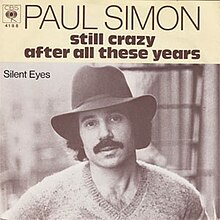Still Crazy After All These Years (song)
| "Still Crazy After All These Years" | ||||
|---|---|---|---|---|
 | ||||
| Single by Paul Simon | ||||
| from the album Still Crazy After All These Years | ||||
| B-side |
| |||
| Released | March 26, 1976 | |||
| Genre | Soft rock | |||
| Length | 3:24 | |||
| Label | Columbia | |||
| Songwriter(s) | Paul Simon | |||
| Producer(s) |
| |||
| Paul Simon singles chronology | ||||
| ||||
"Still Crazy After All These Years" is a song by the American singer-songwriter Paul Simon. It was the third and final single from his fourth studio album of the same name (1975), released on Columbia Records. Though the song briefly reached the top 40 of the Billboard Hot 100 in the U.S., it was a bigger hit on the magazine's Easy Listening chart, where it peaked at number four.[1]
Composition
"Still Crazy After All These Years" begins with the singer singing that "I met my old lover on the street last night."[2] The "old lover" has been variously interpreted to be either Simon's ex-wife Peggy Harper, from whom he was recently divorced, his former girlfriend from the 1960s Kathy Chitty, or even Simon's former musical partner Art Garfunkel, who appears on the following track, My Little Town.[2][3] After sharing a few beers, the singer and the old lover part ways again.[4] The singer notes that he is "not the kind of man who tends to socialize" but rather leans "on old familiar ways" and is "still crazy after all these years."[4] The lyrics acknowledge a nostalgia for the past, but also subtly suggest that once the sweet nostalgia is gone, it is replaced by loneliness and even bitterness.[2]
The song features the Muscle Shoals Rhythm Section: Barry Beckett (Rhodes piano), David Hood (bass guitar) and Roger Hawkins (drums), arranged by Bob James. The saxophone, played by Michael Brecker, emphasizes the jazz character of the song.[2][5] Music theorist Peter Kaminsky analyzed how the key progression of the introduction to "Still Crazy After All These Years" anticipates the key progressions throughout the album.[5] The song has an AABA form, with the first, second and fourth verses sharing the same basic melody.[5] The first and second verses are primarily in the key of G major, although there are some unexpected harmonies that differ between the verses.[5] The key of the third verse, the B section, is never resolved.[5] G major returns in the final verse, but modulates to the slightly higher key of A major, which according to author James Bennighof gives "a faint sense of slightly demented triumph to the singer's declaration that he wouldn't be held responsible for his potential mayhem."[5][6] Music critic Walter Everett considers this modulation to reflect the singer's "unpredictable emotional and mental state."[6]
Reception
Simon has performed the song three times on the late-night comedy series
Charts
| Chart (1976) | Peak position |
|---|---|
| Australia (Kent Music Report)[11] | 10 |
| Canada (RPM) Top Singles[12] | 38 |
| Canada | 2 |
| US Easy Listening (Billboard)[14] | 5 |
| US Billboard Hot 100[15] | 40 |
Other versions
In 1979 Paul Simon suggested to Karen Carpenter that she should include a version of the song on her solo album, then in preparation which was also being produced by Phil Ramone. She had Simon change the words 'crapped out' to 'crashed out'.[16] This recording was released in 1996.[17]
Notes
References
- Allmusic. Retrieved 2014-07-05.
- ^ ISBN 0711955972.
- ISBN 9780470900871.
- ^ ISBN 9780521766470.
- ^ ISBN 9780275991630.
- ^ ISBN 9780199880126.
- ^ Rolling Stone Magazine. Retrieved 2014-07-05.
- ^ "Top Single Picks" (PDF). Billboard. April 24, 1976. p. 62. Retrieved 2020-07-13.
- ^ "CashBox Singles Reviews" (PDF). Cash Box. April 24, 1976. p. 20. Retrieved 2021-12-11.
- ^ "Hits of the Week" (PDF). Record World. April 17, 1976. p. 1. Retrieved 2023-03-06.
- ISBN 0-646-11917-6.
- ^ "RPM100: Singles" (PDF). RPM. 25 (12). Ottawa: Library and Archives Canada. June 19, 1976. Retrieved November 12, 2015.
- ^ "The Programmers' MOR Playlist" (PDF). RPM. 25 (14). Ottawa: Library and Archives Canada. July 3, 1976. Retrieved November 12, 2015.
- ^ "Paul Simon – Chart history". Billboard. Prometheus Global Media. Retrieved November 11, 2015.
- ^ "Paul Simon Chart History (Hot 100)". Billboard. Retrieved November 11, 2015.
- ISBN 978-1-84938-550-3..
- ^ Carpenter, Karen (1996). Karen Carpenter (Media notes). Los Angeles: A&M. 3145405882.
Sources
- Bennighof, James (2007). The Words and Music of Paul Simon. Greenwood Publishing Group. ISBN 978-0-275-99163-0.
- Eliot, Marc (2010). Paul Simon: A Life. John Wiley and Sons. ISBN 978-0-470-43363-8.
